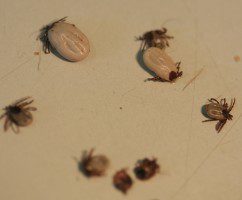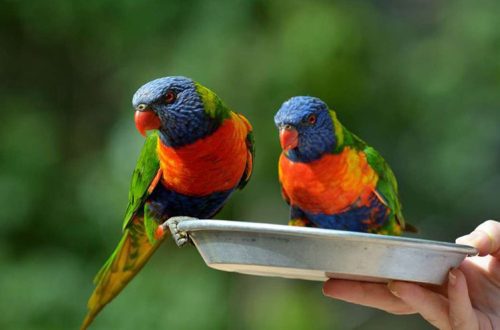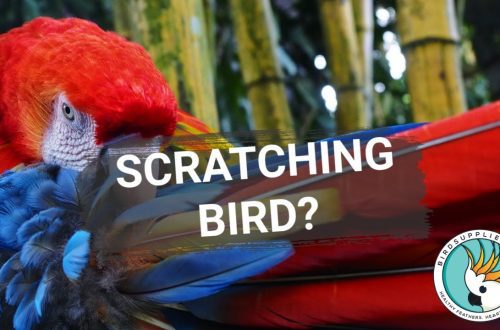
Ticks in a parrot: types, symptoms and treatment
Parrots can suffer from several types of mites. And they can cause serious diseases. Read on for symptoms and effective treatment.
Contents
Budgerigar tick
Such exotic pets as parrots, unfortunately, are the least studied by specialists. Therefore, some diseases go unnoticed even by experienced veterinarians. But even so, more and more bird lovers are getting parrots. To make time with them carefree and joyful, it is worth giving maximum time to their health.
In parrots, various diseases are possible: both infectious and those caused by parasites. The second option is more common. Ticks can become the cause of poor health and even death of parrots.
Parrot tick: photo and its causes
Looking at the presented photo, we can say for sure that in the severe stage of the disease, external changes are difficult not to notice. The tick infects the bird and creates excellent conditions for its reproduction.

It is worth noting that some types of parasites get to the bird along with tree branches, unprocessed food, or through already infected parrots. Also contributing causes are other diseases, stress molting, beriberi, malnutrition or poultry management disorders.
Tick in a parrot: symptoms
Even the owner without proper experience can notice the presence of a tick in an advanced form of the disease. An infected bird constantly itches. If you carefully examine its feathers, you can see small ticks.
But itching can also be caused by molting. The most characteristic symptom of a tick will be eaten feathers with small holes. Also on the pallet in the morning you can see tiny insects.
Tick in a parrot: treatment and types
First of all, it is worth noting that people do not need to be afraid of ticks. They pose no threat to them. As for parrots, even death is possible. They have several types of parasites. Depending on their type, there will be different diseases.

Feather mites in parrots
This type of tick is rare. It affects the core of the pen, because of which it is gradually destroyed. As a result, absolutely all feathers can fall out from a bird. This disease can provoke complete baldness of the parrot.
Tracheal mite in parrots
Symptoms of this disease can be noticed quickly: the bird constantly throws its head back, often breathes, sneezes, and coughs. The parrot may even regurgitate food or refuse it.
At the first sign of infection, you should seek help from a specialist. This will help not only keep the bird healthy, but also save her life.
Scabies mite in parrots
One of the most terrible diseases in birds is knemidokoptosis (scabies mite). These parasites burrow through the epidermis and live on the upper layers of the skin. They feed on tissue fluid, which causes peeling and dry skin on the parrots.

In addition, the tick regularly releases toxins, poisoning the bird. At the initial stage of the disease, parasites cannot be detected, since outwardly they reach only 0,4 mm in size.
Scabies mite in a budgerigar: photos and stages of the disease
Even a specialist, unfortunately, is not able to immediately identify knemidokoptosis. Therefore, the disease moves to a more complex stage. It is important to detect its symptoms as early as possible.
initial stage
Parasites are yet to be found. The incubation period will be four months. The breeder simply does not understand that the bird is infected until they begin to show themselves.
Easy stage
Some symptoms appear. In particular, changes are noticeable on the wax and paws. There are growths of a calcareous shade. The skin also begins to flake and peel off. A parrot can stay on one paw for a long time, cleaning the other with its beak.
middle stage
The influence of parasites is already noticeable to the naked eye. The beak, paws, skin, eyelids are affected. The parrot undermines feathers, behaves lifelessly. Due to the deformation of the beak, the pet stops eating.
severe stage
A parrot can reach this state only with those breeders who do not care at all about his condition. The appearance of the bird is truly frightening: the beak is curved, the skin is covered with growths, there are practically no feathers left. The pet’s joints become inflamed. In the end, the parrot risks losing limbs. Save the bird – chances are low.
How to treat a tick in a parrot
- First of all, the bird should definitely be shown to the doctor. If for some reason this is not yet possible, it is worth purchasing a special parasite control agent at the veterinary pharmacy.
- When choosing a drug, it should be taken into account that many parrots may be allergic to some components. Breeder reviews show that the most popular remedy is aversectin ointment. It is quite inexpensive, easy to use and does not cause an allergic reaction in a parrot.

To treat the affected areas with ointment, you should use a cotton swab. It is impossible for the ointment to get on the beak, nostrils, eyes, plumage of the pet. It should be smeared once every five days and preferably in the evening, when the bird is sleepy. Usually recovery begins after three such procedures.
- If there is no aversectin ointment in the veterinary pharmacy, it can be replaced with vaseline oil. Please note, not vaseline, but oil! With its help, the tick is blocked by oxygen, because of which it dies.
- During the period of illness, flights outside the cage are not allowed.
- If the parrot lives in a pair, the birds should be seated.
- Be sure to disinfect the cage and throw away any wooden devices (swings, perches, ladders, etc.). They may contain eggs of parasites.
- It is equally important to supplement the diet with vitamins and establish a feeding regimen.
How to prevent tick treatment in budgerigars: prevention
Even when the treatment has ended with a complete recovery, the pathogen may still be on the perches, table and other objects in the room. Therefore, it is imperative to carry out a thorough disinfection of all things on which there is a bird.
Be sure to get rid of mineral stones, sticks, food. It is better to replace wooden perches with plastic ones.
And keep a close eye on your pet. If there is the slightest suspicion of infection, consult your veterinarian.





